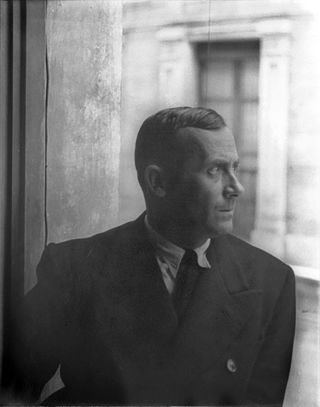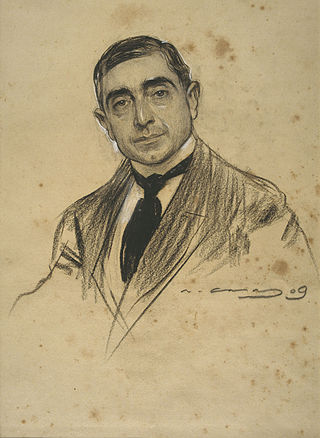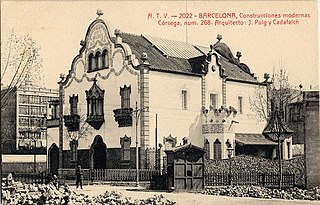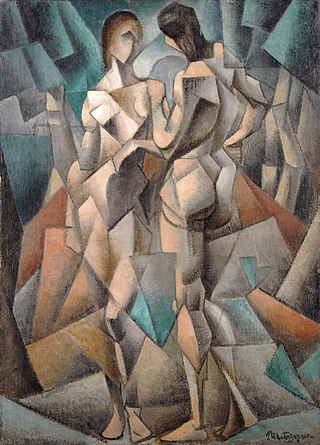
Joan Miró i Ferrà was a Spanish painter, sculptor and ceramicist born in Barcelona. He was known as Joan Miró in the art recognition. A museum dedicated to his work, the Fundació Joan Miró, was established in his native city of Barcelona in 1975, and another, the Fundació Pilar i Joan Miró, was established in his adoptive city of Palma in 1981.

Dionís Baixeras i Verdaguer (1862–1943) was a naturalist Spanish artist from Barcelona, who specialized in oil on canvas and was noted for his realistic and detailed Orientalist and everyday life scenes.

The Museu Nacional d'Art de Catalunya, abbreviated as MNAC, is a museum of Catalan visual art located in Barcelona, Catalonia, Spain. Situated on Montjuïc hill at the end of Avinguda de la Reina Maria Cristina, near Pl Espanya, the museum is especially notable for its outstanding collection of romanesque church paintings, and for Catalan art and design from the late 19th and early 20th centuries, including modernisme and noucentisme. The museum is housed in the Palau Nacional, a huge, Italian-style building dating to 1929. The Palau Nacional, which has housed the Museu d'Art de Catalunya since 1934, was declared a national museum in 1990 under the Museums Law passed by the Catalan Government. That same year, a thorough renovation process was launched to refurbish the site, based on plans drawn up by the architects Gae Aulenti and Enric Steegmann, who were later joined in the undertaking by Josep Benedito. The Oval Hall was reopened in 1992 on the occasion of the Olympic Games, and the various collections were installed and opened over the period from 1995 to 2004. The Museu Nacional d'Art de Catalunya was officially inaugurated on 16 December 2004. It is one of the largest museums in Spain.

Jordi Pagans i Monsalvatje was a Catalan and Spanish painter.

Els Quatre Gats is a café in Barcelona, Catalonia, Spain that famously became a popular meeting place for famous artists throughout the modernist period in Catalonia, known as Modernisme. The café opened on 12 June 1897 in the famous Casa Martí, and served as a hostel, bar and cabaret until it eventually became a central meeting point for Barcelona's most prominent modernist figures, such as Pablo Picasso and Ramon Casas i Carbó. The bar closed due to financial difficulties in June 1903, but was reopened and eventually restored to its original condition in 1989.

Santa Maria de Montserrat is an abbey of the Order of Saint Benedict located on the mountain of Montserrat in Monistrol de Montserrat, Catalonia, Spain. It is notable for enshrining the image of the Virgin of Montserrat. The monastery was founded in the 11th century and rebuilt between the 19th and 20th centuries, and still functions to this day, with over 70 monks. There have always been roughly 80 monks in residence.

Josep Llimona i Bruguera was a Spanish sculptor. His first works were academic, but after a stay in Paris, influenced by Auguste Rodin, his style drew closer to modernisme. He was very prolific, and exhibited in Catalonia, Madrid, Paris, Brussels and Buenos Aires. Some of his monumental work is familiar to Barcelona residents and visitors alke.

The Cercle Artístic de Sant Lluc is an arts society which was founded in Barcelona (Catalonia) in 1893 by Joan Llimona, Josep Llimona, Antoni Utrillo, Alexandre de Riquer, the city councillor Alexandre M. Pons and a group of artists who were followers of bishop Josep Torras i Bages, as a reaction to the anticlerical current present in modernisme and in the Cercle Artístic de Barcelona, which they considered to be frivolous. The society was typified by its vigorous defence of Catholic morals and of family virtue, and its desire to follow in the path of humility that was pursued by the mediaeval guilds.

Antoni Gaudí i Cornet was a Spanish architect and designer from Catalonia, known as the greatest exponent of Catalan Modernism. Gaudí's works have a highly individualized, sui generis style. Most are located in Barcelona, including his main work, the church of the Sagrada Família.

The Olot school of landscape painting is a group of painters that created an artistic style in the second half of the 19th century. It includes not simply artists from Olot, but all artists whose artworks were inspired by the countryside of Olot. By extension, artists connected with Olot and its comarca, Garrotxa.

Portrait of Vincent Nubiola is an 1917 oil painting by Spanish artist Joan Miró. Painted in 1917 when Miró was 24 years old, a year before his first exhibition, the portrait is now considered a masterpiece from a period when he experimented with both Cubism and Fauvism. It is also said by some art critics to show the influence of Van Gogh. Acquired for a time by Picasso, the painting is now in the permanent collection of the Folkwang Museum in Essen (Germany).

Desolation is a sculpture made by Josep Llimona 1907 which is part of the collection of the National Art Museum of Catalonia in Barcelona.

Casa Trinxet was a building designed by the Catalan Modernisme architect Josep Puig i Cadafalch and built during the years 1902–1904, officially considered completed in 1904. It was located at the crossroads of Carrer Balmes and Carrer del Consell de Cent, in the Eixample district of Barcelona, Catalonia, Spain. Casa Trinxet was "one of the jewels of Barcelona Modernisme" and one of the buildings of Barcelona's Illa de la Discòrdia, because of competing attitudes among Domènech i Montaner, Puig i Cadafalch and Antoni Gaudí.

Joaquin Mir Trinxet or Joaquin Mir y Trinxet was a Catalan artist known for his use of color in his paintings. He lived through a turbulent time in the history of his native Barcelona. His paintings helped to define the Catalan art movement known as modernisme.

Pelegrí Clavé i Roqué sometimes Pelegrin Clavé was a Spanish painter in the Romantic style who lived and taught in Mexico for many years.

Enric Clarasó i Daudí was a modernist Catalan sculptor.

Public art in Barcelona is a designated group of monuments and outdoor sculptures in the city. The artworks in city's architecture and network of museums, parks, and gardens, put an artistic stamp on the Catalan capital. Public art in the city developed in the 19th century, although the first municipal commission was the 1673 monument to Saint Eulalia in Pedró Square.

The Sala Parés is the oldest art gallery in Barcelona, Spain. Initially an art store, established in 1840 by Joan Parés, it slowly evolved into a gallery and formally became one in 1877.

Galeries Dalmau was an art gallery in Barcelona, Spain, from 1906 to 1930. The gallery was founded and managed by the Symbolist painter and restorer Josep Dalmau i Rafel. The aim was to promote, import and export avant-garde artistic talent. Dalmau is credited for having launched avant-garde art in Spain.























